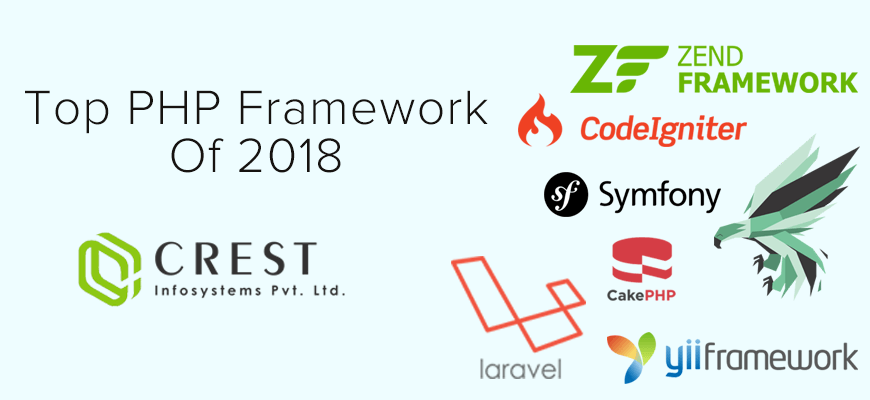PHP frameworks simplify development by offering reusable components, security features, and can grow easily. Whether you are building a small web app or a large enterprise solution, choosing the proper PHP framework is crucial.
This guide covers the top PHP frameworks, their features, pros and cons, and best use cases to help you choose the right one for your project.
Table of Contents
Why use a PHP Framework?
- Faster Development – Reduces repetitive coding with pre-built modules.
- Better Security – Protection against SQL injection, XSS, and CSRF.
- Growth potential – Helps handle high traffic and growing applications.
- Code is simple to maintain – Follows MVC (Model-View-Controller) structure for organized code.
1. Laravel – The Most Popular PHP Framework
Introduction:
Laravel is the most widely used PHP framework, known for its elegant syntax and modern features.
It has built-in user verification, routing, caching, and database migration tools, making it ideal for large-scale applications.
Advantages:
- Elegant and developer-friendly syntax
- Built-in user verification and access control.
- Strong ecosystem (Forge, Envoyer, Nova, Vapor)
- Supports WebSockets with Laravel Reverb
Drawback:
- It can be slow for lightweight applications.
- Requires good hosting to handle resource demands
Best For:
- Large-scale applications
- REST APIs
- Enterprise solutions
Read More: Laravel vs Other PHP Frameworks
2. Symfony – The Enterprise-Grade PHP Framework
Introduction:
Symfony is a robust and flexible PHP framework that enterprises and large applications prefer. It provides reusable PHP components, follows industry standards for easy update, and can grow easily.
Advantages:
- Modular component-based system
- Long-term support (LTS) versions are available
- Built-in testing with PHPUnit
- Great for building reusable PHP components
Drawback:
- The steepening curve for beginners
- More complex than Laravel for small projects
Best For:
- Large, complex applications
- Corporate applications requiring long-term support
- Developers who need reusable PHP components

3. CodeIgniter – The Fast and Lightweight Framework
Introduction:
CodeIgniter is a simple, high-performance PHP framework. It is perfect for developers who need a lightweight solution without too many dependencies.
Advantages:
- Extremely lightweight (only 1.2MB)
- Excellent performance with minimal configurations
- Secure and robust against common web threats
- Easy to learn for beginners
Drawback:
- Limited built-in features compared to Laravel and Symfony
- Smaller community support
Best For:
- Beginners looking for an easy framework
- Projects needing a fast and lightweight solution
- Small and medium-sized applications
Read More: Best open-source E-commerce platform
4. Yii2 – The High-Performance PHP Framework
Introduction:
Yii2 is known for its speed and security, making it an excellent choice for performance-critical applications. It comes with built-in caching and a robust security system.
Advantages:
- Fast loading with lazy loading techniques
- Excellent security features
- Built-in RESTful API support
- Seamless third-party integration
Drawback:
- Smaller community compared to Laravel and Symfony
- Less beginner-friendly
Best For:
- High-performance applications
- E-commerce platforms
- Applications requiring high security
5. Laminas (formerly Zend Framework) – The Object-Oriented PHP Framework
Introduction:
Laminas (previously Zend Framework) is a highly flexible, object-oriented PHP framework for enterprise-level applications. Best suited for developers who need complete control over their code.
Advantages:
- Developers can easily change this highly easy to change, object-oriented framework.
- Supports MVC and middleware
- Excellent security features
- Well-suited for enterprise applications
Drawback:
- Steep learning curve
- Requires more configurations
Best For:
- Enterprise applications
- Complex applications with custom requirements
- Developers prefer an object-oriented approach
6. Phalcon – The Fastest PHP Framework
Introduction:
Phalcon is a fast PHP framework built as a C extension. This allows it to work directly with PHP for better performance.
Advantages:
- Built as a C extension for PHP (Swift)
- Low memory consumption
- MVC architecture with minimal overhead
- Direct interaction with PHP internals
Drawback:
- Requires server support for C extension
- Not as beginner-friendly
Best For:
- High-speed applications
- Applications with limited server resources
- Developers need maximum performance
7. CakePHP – The Rapid Development Framework
Introduction:
CakePHP uses a “convention over configuration” approach, allowing developers to build applications quickly with minimal setup.
Advantages:
- Simple and intuitive CRUD operations
- Built-in security and user verification
- Convention-over-configuration approach
- Robust ORM and scaffolding system
Drawback:
- Not as flexible as Laravel or Symfony
- Less popular compared to other frameworks
Best For:
- Startups needing quick deployment
- Small business applications
- Developers looking for a Rails-like experience in PHP
Conclusion
Choosing the proper PHP framework depends on your project requirements. Understanding each framework’s strengths and best use cases will help you choose the right one to streamline development in 2025.


